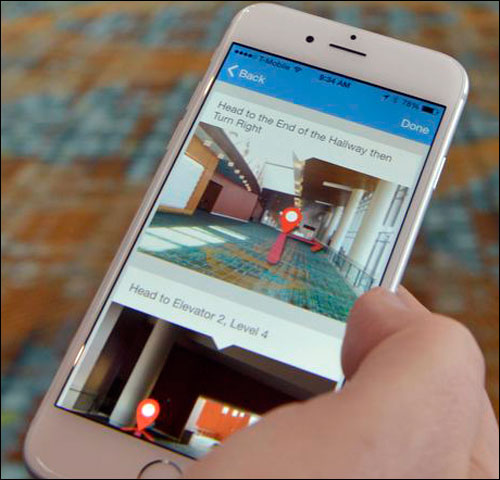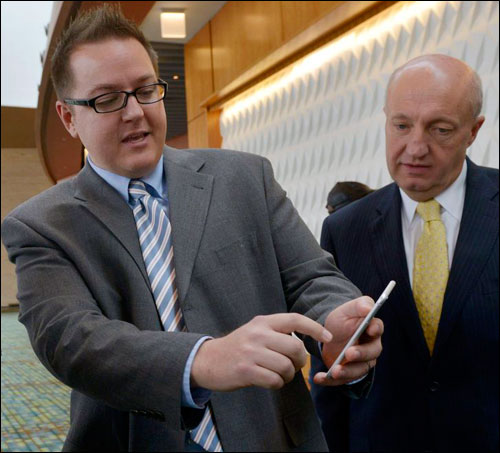Nov 24, 2014Beginning last week, visitors to the Music City Center in Nashville, Tenn., no longer need to look at signage or maps to navigate their way around the 1.2-million-square-foot convention complex. Instead, they can simply glace at an app running on their Android or iOS device to identify where they are, and to view directions to reach their chosen destination, along with pictures of what the route should look like along the way.
The solution uses data transmitted by 64 Bluetooth beacons installed throughout the site, developed by Jules White, an assistant professor of electrical engineering and computer science at Vanderbilt University, as well as an associate named Yu Sun and some of White's software engineering students. Following beta-testing of the beacon-based solution at the Music City Center and subsequent permanent deployment, White has launched a Bluetooth Low Energy (BLE)-powered indoor navigation solutions firm called Ziiio that is currently in conversations with several potential customers that include hospitals and outdoor festivals.

The Music City Center project launched more than a year ago, White says, when he began talking to Yiaway Yeh, Nashville's co-chief innovation officer (and the former mayor of Palo Alto, Calif.), about ways in which technology could solve problems in Nashville. At the time—spring 2013—the Music City Center had recently celebrated its grand opening (on May 20), and White says he learned from the convention center's organizers that navigation was a major challenge due to the complex's size. Another challenge, he says, was the fact that most visitors would be coming to the center for the first time, and would need to look at signage and maps in order to find conference rooms, food, restrooms or other facilities.
White says he began working with his students to create a smartphone app using BLE technology to identify an individual's location. He and Sun carried out most of the development work in summer 2014, creating the app and setting up 64 beacons donated by BKON Connect, a local manufacturer of beacon hardware, software and services. BKON had learned of the Vanderbilt University and Music City Center beacon-based project, according to Richard Graves, the company's founder and CEO, and, as another Nashville company, offered its products. White's group created algorithms so that the app could pinpoint an individual's location based on the transmissions received from the beacons.

Each BKON Connect A1 battery-powered beacon—measuring 60 millimeters by 36.5 millimeters by 18.75 millimeters (2.4 inches by 1.4 inches by 0.7 inch)—is installed in the junction boxes used for Ethernet ports mounted about a foot and a half above the floor. The boxes, White says, do not necessarily offer the best position for transmitting BLE signals to smartphones—high mounting locations, such as on a ceiling, would be optimal—but they were the only locations available to the facility. In addition, the Ethernet boxes provided a way to hide the beacons from any damage or theft. The beacons have a transmission range of about a 150-foot radius, and altogether provide 100 percent coverage of the building's public area.
In most locations, a phone running the app would receive transmissions from multiple beacons, which would help the app determine exactly where the user was located within the convention center. The challenge is not in gaining location granularly within a few feet, White notes, but in confirming that an individual is within a specific room or public area, or on a specific floor, based on the beacon data being received. This, he says, can prove difficult for a layout as complicated as that of the Music City Center, which has unusual angles and structural elements that can reflect RF signals.
Once the system was installed, White says, some beta-testing took place early this fall. The greatest surprise during that testing, he reports, was how well the system worked. He and his team provided 50 people with the app. Those users input locations they wished to find, and then followed the navigation prompts, which included photographic images of the areas in which they were walking, based on beacon transmissions received by their phones. "We had 100 percent success," he states. To further improve the solution, his team included a function in the app to allow an individual to indicate, by pressing a thumbs-up or thumbs-down icon, whether the directions led that person where he or she wanted to go.
With the app, the Music City Center can now update search details provided to users on a daily basis, according to which events are underway in the building at any given time. If there are conferences taking place on the premises, however, the app will not initially include specific details related to each event, such as specific session locations or speakers being hosted. Instead, conference goers can use the app to find, for instance, the registration desk, Room 2B, a restroom or food.
The Music City Center can also access location data to gain analytics regarding the movements of foot traffic within its public area. This information, stored on a cloud-based server, enables the center's organizers to identify any congestion or problems that might arise, and to address those issues. They could, for instance, determine which doors are experiencing a high level of traffic, and whether they should thus assign extra security officials to cover that area.
Ziiio is currently working on solutions for the health-care industry, White says. In hospitals, the technology could be used by patients or other visitors who, upon entering the facility, must find their way to a particular department, patient room or cafeteria. He notes that although most hospitals post directions at the entrances to the imaging area and other departments, navigating hallways can become confusing, especially for those who may not be physically healthy.
In the case of hospital use of the technology, White says, analytical data about the movements of individuals would also be useful. The software would typically be stored on a local private network in order to guarantee data security.
Free to users, the app is available at the iPhone and Android devices websites. Hospitals, conference centers, festival organizers and other businesses would pay a monthly fee for the service, which would include the beacons and access to the app-generated data.

